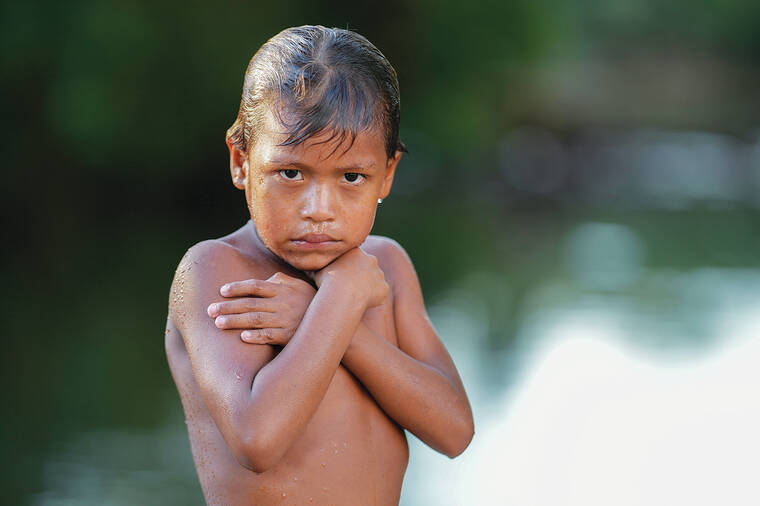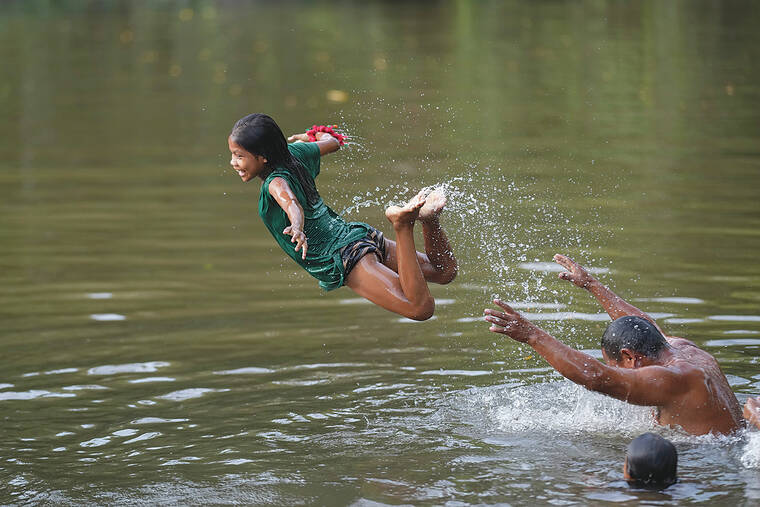Indigenous leader inspires an Amazon city to grant personhood to an endangered river
GUAJARA-MIRIM, BRAZIL — On the banks of the Komi Memem River, the activity never ceases: women go down the embankment from Laje Velho village carrying basins to wash clothing, while men embark in small canoes on hunting and fishing expeditions. At day’s end, it’s the children’s turn to dive into its tea-colored waters.
The river, named Laje in non-Indigenous maps, is vital to the Oro Waram, one of the six subgroups of the Wari’ people, who have inhabited the Western Amazon for centuries. However, this immemorial relationship is under increasing threat. The relentless expansion of soybeans and pastures encroaches on their land, while land-robbers promote illegal deforestation.
To protect themselves, the Wari’ people are resorting to a new strategy: the white man’s law. In June, the municipality of Guajara-Mirim passed a groundbreaking law proposed by an Indigenous councilman that designates the Komi Memem and its tributaries as living entities with rights, ranging from maintaining their natural flow to having the forest around them protected.
The law comes as representatives of eight South American governments gather Tuesday and Wednesday in Brazil to discuss ways to preserve the Amazon rainforest to help stave off climate change and protect its Indigenous peoples.
The Komi Memem, a tributary of a larger river that’s unprotected, is now the first among hundreds of rivers in the Brazilian Amazon to have a law that grants it personhood status. This is part of a new legislative approach to protect nature that has made inroads in many parts of the world, from New Zealand to Chile.
“We are further organizing ourselves to fend off invaders,” councilman Francisco Oro Waram, the law’s proponent, told The Associated Press. “We can’t fight with arrows; we have to use the laws.”
A teacher by profession, Oro Waram lives with his family in Laje Velho village, a 40-minute drive from downtown Guajara-Mirim, mostly on paved highway surrounded by pasture. Right before the village entrance, heavy machinery was preparing soil for soybean crops, which are fast replacing cattle ranching throughout this part of the Amazon in Rondonia state.
“There are many generations to come, so the elders protect the water,” Oro Waram said of the river. “We don’t pollute it or cut the trees that surround it. It is a living being for us.”
Satellite images show the encirclement of the Indigenous Land Igarapé Lage, a green rectangle amid deforestation. This is where Laje Velho is located. In the past decades, the federal government has created six non-continuous Indigenous territories. One, Rio Negro Ocaia, has been awaiting the federal government’s approval of the expanded boundaries established by an anthropological study 15 years ago.
The Wari’ people lived independently until the late 1950s and early 1960s and are the largest group of Chapakuran speakers, an isolated language family.
In the initial years after contact with outsiders, three out of five Wari’ died from introduced diseases, dwindling to as low as 400 people. The population has increased tenfold since then, but they now occupy less than one-third of their original territory, according to anthropologist Beth Conklin from Vanderbilt University, who has worked with them for nearly four decades.
“The Wari’ value their cosmology and rituals. And all of it centers around promoting human thriving in relationships with the non-human, with the larger world, and the well-being of your people,” Conklin told the AP. “So this law is a 21st century update of these very traditional social, biological, ecological values that are at the center of Wari’ culture.”
The expansion of soy, with heavily pesticide-dependent crops, poses a significant threat to the Komi Memem River. But it is not the only one. Upriver from Laje Velho, an invasion by land-robbers has blocked the Wari’ people from accessing their essential fishing grounds.



